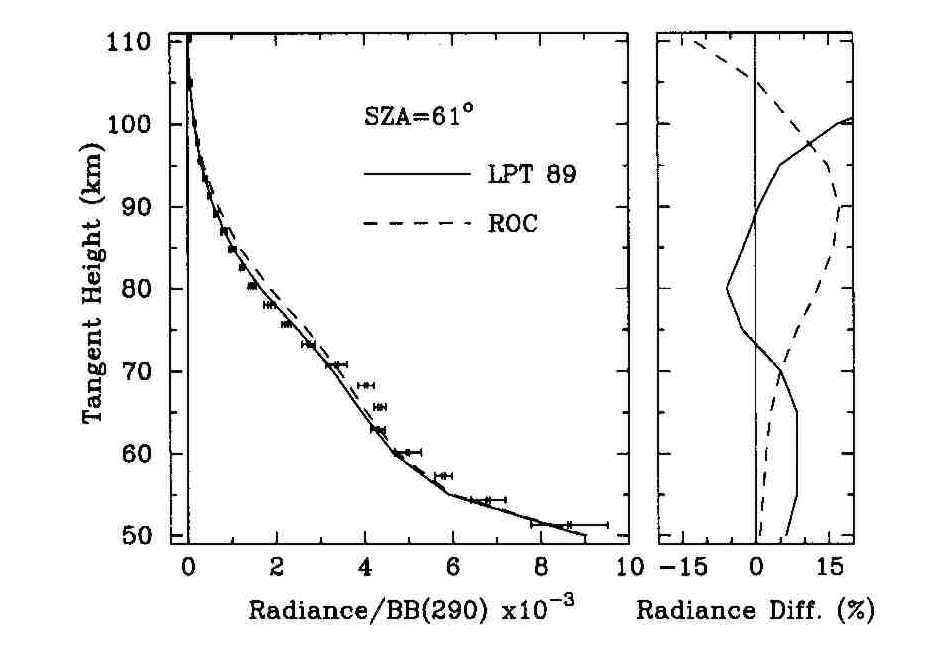|
CO2 Abundances in the upper atmosphere from the
Analysis of ISAMS measurements at 4.6 um.
This is a short summary of a work conducted during several year by our group
and the Dept. of Physics of the Oxford University. The results have been
published in the following two papers:
Non-local thermodynamic equilibrium (LTE) atmospheric limb
emission at 4.6 um, 1: An update of the CO2 non-LTE radiative
transfer model.
Lopez-Puertas et al., JGR, 103, pp.8499-8513, 1998.
Postscript File [ GNUzipped Tar files , 165 Kb ]
Non-local thermodynamic equilibrium (LTE) atmospheric limb
emission at 4.6 um, 2: An analysis of the daytime wideband
radiances as measured by UARS improved stratospheric and
mesospheric sounder
Lopez-Puertas et al., JGR, 103, pp.8515-8530, 1998.
Postscript File [ GNUzipped Tar files , 225 Kb ]
The measurements carried out by the ISAMS instrument, on board UARS,
in its wide band channel at 4.6 um have a good signal to noise ratio
up to the lower thermosphere and present a clear signature of non-LTE
enhancement, as shown in Figure 1.
 Figure 1.
Variation of the ISAMS 00W radiances with solar zenith
angle (SZA) and with altitude for UARS day 124 (January 14, 1992). Radiances
have been averaged in boxes of 1/3 scale height in altitude and 5 degree
in SZA, and plotted on a log scale in units of a black body at 290 K.
We have analyzed them and show that this daytime enhancement is due to CO2
4.3 um isotopic and hot bands emissions. A detailed modelling of these
emissions has permitted to understand the observed profiles and the SZA
dependence shown in Figure 1. The simulations had to include a very large
number of bands of CO2, appart from N2O and O3 infrared bands, and the
excitation of N2(1) by the transfer of the electronically excited O(1D).
Since the ISAMS radiances are very sensitive to the actual CO2 vmr used,
we have studied such sensitivity and found that a profile derived
previously from a similar analysis of SAMS/NIMBUS-7 measurements, but
adjusted to 350 ppmv below 75 km, fits the radiances very well (see Figure
2). Notice that this profile is significantly lower than the mean of a
number of rocket experiments, and also a bit lowe than the CO2 values
derived from ATMOS data. We also obtained that within the ISAMS accuracy,
little seasonal and latitude variations are observed, that is, the CO2 vmr
must present variations smaller than 20 %.
Figure 1.
Variation of the ISAMS 00W radiances with solar zenith
angle (SZA) and with altitude for UARS day 124 (January 14, 1992). Radiances
have been averaged in boxes of 1/3 scale height in altitude and 5 degree
in SZA, and plotted on a log scale in units of a black body at 290 K.
We have analyzed them and show that this daytime enhancement is due to CO2
4.3 um isotopic and hot bands emissions. A detailed modelling of these
emissions has permitted to understand the observed profiles and the SZA
dependence shown in Figure 1. The simulations had to include a very large
number of bands of CO2, appart from N2O and O3 infrared bands, and the
excitation of N2(1) by the transfer of the electronically excited O(1D).
Since the ISAMS radiances are very sensitive to the actual CO2 vmr used,
we have studied such sensitivity and found that a profile derived
previously from a similar analysis of SAMS/NIMBUS-7 measurements, but
adjusted to 350 ppmv below 75 km, fits the radiances very well (see Figure
2). Notice that this profile is significantly lower than the mean of a
number of rocket experiments, and also a bit lowe than the CO2 values
derived from ATMOS data. We also obtained that within the ISAMS accuracy,
little seasonal and latitude variations are observed, that is, the CO2 vmr
must present variations smaller than 20 %.
 Figure 2.
Effect of the CO2 vmr profile on the modeled radiances
for the reference case. The right panel shows the percentage differences
between the modeled radiances using 'ROC' and 'LPT' profiles of CO2
(dashed line), and between the measured and the 'LPT' modeled radiances
(solid line).
Figure 2.
Effect of the CO2 vmr profile on the modeled radiances
for the reference case. The right panel shows the percentage differences
between the modeled radiances using 'ROC' and 'LPT' profiles of CO2
(dashed line), and between the measured and the 'LPT' modeled radiances
(solid line).
|







